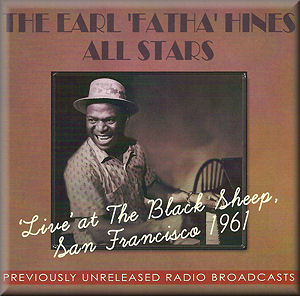CD1
1. Deep Forest and Intro
2. Beale Street Blues
3. Riverboat Shuffle
4. Lonesome Road
5. Darktown Strutters Ball
6. Deep Forest and Intro
7. Fidgety Feet
8. I Love You Because I Love You
9. Mahogany Hall Stomp
10. Stardust
11. The World Is Waiting for the Sunrise
12. Lady Be Good
13. Deep Forest and Intro
14. I Wish I Could Shimmy Like My Sister Kate
15. Panama Rag
16. St. James Infirmary
17. Limehouse Blues
18. Lady Be Good
CD2
1. Deep Forest and Intro
2. South Rampart Street Parade
3. Yes Sir That's My Baby
4. Clarinet Marmalade
5. The Memphis Blues
6. Deep Forest and Intro
7. Jazz Me Blues
8. Lonesome Road
9. Dippermouth Blues
10. Do You Know What it Means to Miss New Orleans?
11. The Bucket's Got a Hole in it
12. Deep Forest and Intro
13. Dallas Blues
14. Manhattan
15. West End Blues
16. Wolverine Blues
17. Please Play For Me the Sweet Melody Doodle-Ee-Doo
Earl Hines - Piano
Jimmy Archey - Trombone
Darnell Howard - Clarinet
Pops Foster - Bass
Earl Watkins - Drums
Eddie Smith - Trumpet (tracks I/1-12, II/12-17)
Ernie Figueroa - Trumpet (tracks I/13-18)
Byron Berry - Trumpet (tracks II/1-11)
In the 1950s and 1960s, broadcaster Ken Ackerman collected tapes of jazz performances. His collection is now housed in the Archive of Recorded Sound at San Francisco's Stanford University. Fortunately for us, recordings of Earl Hines playing at the Black Sheep club in Frisco have been released for the first time on this double CD. It comprises six radio shows broadcast in April and May 1961.
Earl Hines was an ebullient bandleader, introducing every tune and urging on his musicians with shouts of approval. His cheerful comments create a party atmosphere which obviously goes down well with the enthusiastic audience. His announcement on the first session (14 April 1961) indicates that the Black Sheep had just opened, and Earl did his best to promote the club through these 25-minute broadcasts. Hines got the nickname "Fatha" while he was leading a big band at the Grand Terrace in Chicago. In one show, the announcer said "Here comes Fatha Hines through the deep forest with his little children". Deep Forest was Earl's signature tune, as you can hear at the start of each of these broadcasts.
When Hines came to California, he discovered that he was meant to play in the Dixieland style - something he had not done much before. But he adapted well to people's expectations, assisted by musicians who were mostly veterans familiar with Dixieland. Hines' adaptability is evident in the way he deals with a rather tinny piano best suited to a honky-tonk. This may be the reason why he doesn't play a lot of solos, although he still gets the chance to display his "trumpet-style" piano in such tunes as Do You Know What it Means to Miss New Orleans? and Lonesome Road. He plays some impressive runs as well as providing a firm backing for the other musicians.
Much of the repertoire consists of venerable Dixieland material likely to appeal to the audience, but there are also some unexpected delights. Lady Be Good (one day people may remember that it's called "Oh, Lady be Good!") appears twice on the album but the two versions are very different. The first is a short version to close a broadcast with collective improvisation; the second starts with an "orchestral" Hines piano solo and he even adds a vocal. Rodgers & Hart's Manhattan may not appear to be regular Dixieland fare but Hines plays the melody with rhythmic grace, mostly backed just by bass and drums.
The front-line musicians all acquit their roles expertly. My only grouse about this CD is with the song titles printed on the rear sleeve. These are printed in blue on a brown background, which makes them almost impossible to read. But one can forgive this when the music is all so splendid. I am glad that these recordings have been dug out from the archives - let us hope for more.
Tony Augarde
www.augardebooks.co.uk
